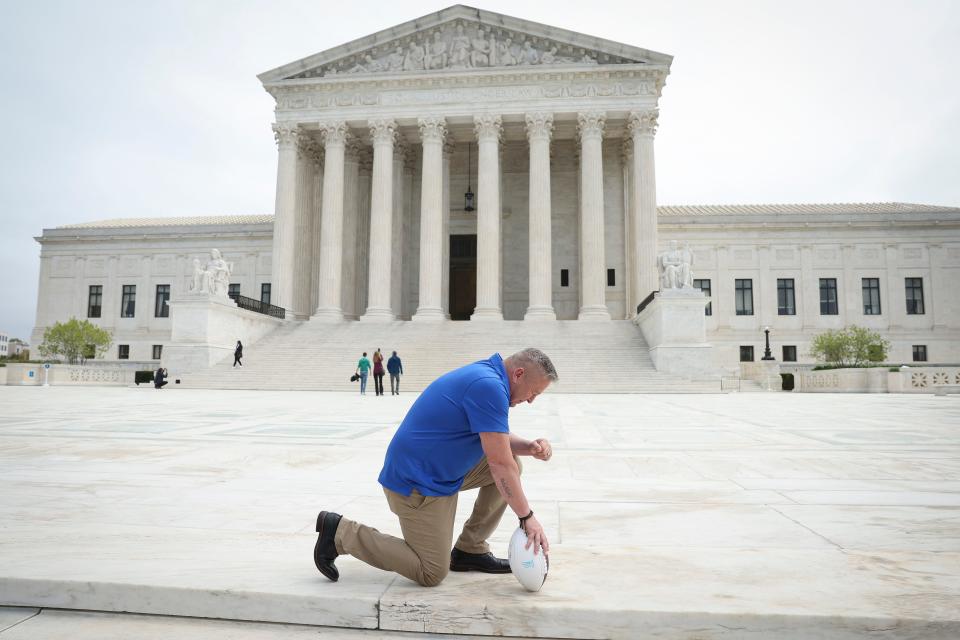Fact check: Religious displays on government property are determined case by case
- Oops!Something went wrong.Please try again later.
The claim: Supreme Court says Jewish symbols allowed on government property but not Christian symbols
A Dec. 26 Instagram post (direct link, archived link) shows a menorah in front of the White House.
“Reminder the Supreme Court says Jewish symbols are permitted on government property, but not Christian ones,” reads the text in the image.
The post was liked more than 1,000 times within two months.
Follow us on Facebook! Like our page to get updates throughout the day on our latest debunks
Our rating: Partly false
Although one Supreme Court case did uphold the display of a menorah and strike down a nativity scene, the ruling was not a universal one. . There has been no Supreme Court ruling that included a blanket ban on Christian symbols or a sweeping approval of symbols from Judaism or other religions, legal experts say. The constitutionality of religious symbols displayed on government property is reviewed on a case-by-case basis.
Context key to religious displays
“There has never ever been a rule that some religions are permitted and others are barred,” said Douglas Laycock, a professor at the University of Virginia School of Law.
Instead, he said, situations are reviewed on a case-by-case basis.
But there is no clear or coherent test used to determine whether a display of a religious symbol is constitutional. Based on previous rulings, the high court tends to uphold religious symbols when displayed in a context containing other secular symbols or when the religious symbol has an alternative secular meaning, said Frederick Gedicks, a professor at Brigham Young University Law School.
Fact check: Story of Texas teen receiving 96-year prison sentence for abortion is satire
Gedicks noted the 2019 case American Legion v. American Humanist Association upheld a giant Latin cross built as a World War I memorial, and the 2005 case Van Orden v. Perry upheld a 10 Commandments monument set among other secular monuments.
Courts used to use the Lemon test, a more clear-cut set of contextual factors when judging government interactions with religion. But a 2022 Supreme Court opinion abandoned the test, Gedicks said.

In the opinion, which sided with a coach that prayed on a high school football field, the Supreme Court advised other courts to instead refer to previous rulings regarding the government’s interaction with religion, said Caroline Corbin, a professor at the University of Miami School of Law.
“There are no hard and fast rules with regard to any particular religion,” Corbin said.
Post incorrectly refers to 1989 case
The post is incorrectly interpreting a 1989 Supreme Court case, Allegheny County v. ACLU, multiple experts told USA TODAY.
The case considered the constitutionality of two religious displays: a nativity scene displayed by itself in the lobby of a county courthouse and a Christmas tree displayed alongside a menorah outside a city-county building.
The high court struck down the lone nativity scene because it endorsed “a patently Christian message,” reads the opinion.
But it permitted the menorah and the Christmas tree because it “endorsed pluralism, not any one religion,” Laycock said.
Experts said this ruling did not permit all Jewish symbols on government property while banning all Christian ones. The court has upheld displays of Christian symbols on public property multiple times in the past.
The social media user who shared the claim did not provide any evidence to support it when contacted by USA TODAY.
Our fact-check sources:
Douglas Laycock, Feb. 28, Email interview with USA TODAY
Marci Ann Hamilton, Feb. 28, Email interview with USA TODAY
Holly Hollman, Feb. 28, Email interview with USA TODAY
Frederick Gedicks, Feb. 26, Email interview with USA TODAY
Michael McConnell, Feb. 24, Email interview with USA TODAY
Elizabeth Reiner Platt, Feb. 24, Email interview with USA TODAY
Caroline Corbin, Feb. 24, Email interview with USA TODAY
The Supreme Court, accessed March 1, American Legion v. American Humanist Association
The Supreme Court, accessed March 1, Bremerton School District v. Kennedy
Justia, accessed March 1, Van Orden v. Perry
Justia, accessed March 1, Allegheny County v. ACLU
Middle Tennessee State University, accessed March 1, Lemon test
Thank you for supporting our journalism. You can subscribe to our print edition, ad-free app or electronic newspaper replica here.
Our fact-check work is supported in part by a grant from Facebook.
This article originally appeared on USA TODAY: Fact check: Religious symbols on public display judged case by case

